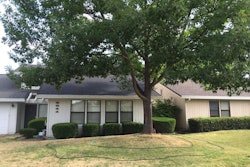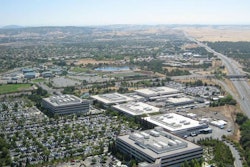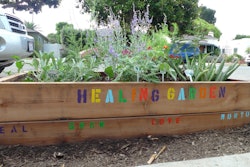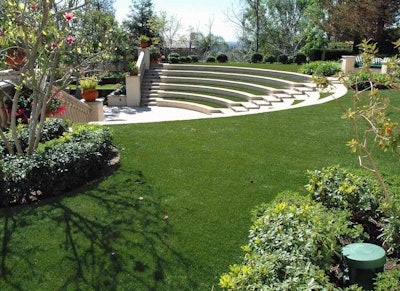 A small amphitheater project featuring artificial grass from Dallas-based Everlast Turf. Everlast is one of two brands of artificial turf distributed by Synthetic Grass Warehouse.
A small amphitheater project featuring artificial grass from Dallas-based Everlast Turf. Everlast is one of two brands of artificial turf distributed by Synthetic Grass Warehouse.Photo: Everlast Turf
With Mother Nature in his corner – not to mention a cheering section comprising nine out of 10 Americans, according to a recent Harris Poll – you’d think Tobey Wagner would be content to ignore any limited gains in market share enjoyed by the U.S. synthetic turf industry.
You’d be wrong about that: The owner and president of Sod Solutions is anything but sanguine about artificial grass, which Wagner clearly sees as a pox on humankind. “I can’t think of a more harmful thing that we could do to our environment than using synthetics,” he says. “The only reason synthetic turf is used at all is just a lack of education about the reality of it.”
Based in Mount Pleasant, South Carolina, Sod Solutions is a developer and marketer of turf grasses. Its founder talks about synthetic grass like someone who competes against it and Wagner markets natural turf with the same competitive urgency.
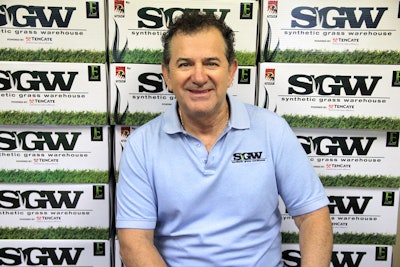 Victor Lanfranco, co-owner of Synthetic Grass Warehouse.
Victor Lanfranco, co-owner of Synthetic Grass Warehouse.For Victor Lanfranco, co-owner of the nation’s largest distributor of artificial turf, Synthetic Grass Warehouse (SGW) in Anaheim, California, competing effectively means doing a sufficient job of explaining how much better artificial grass is today than it was 25 years ago. “The engineering – the technology – has come a long, long way, especially in the last decade,” he says. “It’s now a widely accepted product for the landscape,” not just athletic fields.
SGW is 100-percent focused on the distribution of artificial turf – most of it from TigerTurf, one of the industry’s top brands, which is owned by TenCate subsidiary TenCate Grass of Union City, Georgia, and the remainder from Dallas-based Everlast Turf. SGW does offer a few accessory products such as chemical treatments for areas used by pets.
Lanfranco says SGW has achieved revenue increases of 15-20 percent a year for the past decade. “The drought (in California) may take us to 30 percent this year,” he says, insistent that the growth of the industry as a whole is obvious, notwithstanding the scarcity of publicly traded artificial-turf companies, which would be required to make key financial information public. And to be fair, the same limitation applies to the natural turf industry.
“Keeping up with demand is a challenge,” Lanfranco says, not for SGW alone but for all companies that make and sell synthetic turf.
In separate telephone interviews, Wagner and Lanfranco talked about their own businesses as well as the other’s. The subject was deliberately limited to landscaping for commercial, residential and governmental customers; in other words, athletic fields – a huge but different kind of business in many respects – were purposely excluded.
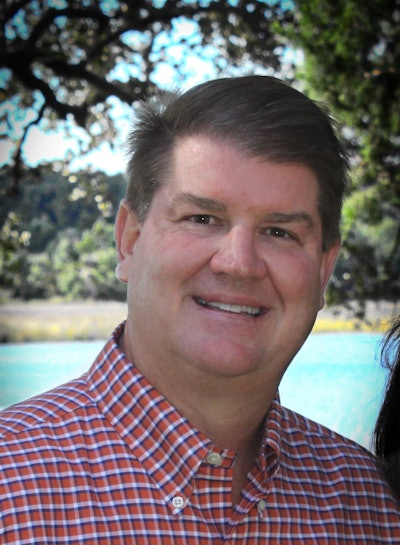 Tobey Wagner, owner and president of Sod Solutions
Tobey Wagner, owner and president of Sod SolutionsWagner, after graduating from Auburn University with a degree in mechanical engineering, worked his way into the turf industry, eventually starting Sod Solutions about 21 years ago. “Lots of people in the business see us as a marketing company,” he says, “but we have horticulturalists and others in that area working with us every day. We’re very involved in (the) development” of grasses.
Sod Solutions’ clients include turf-growing operations nationwide, with which it forms affiliation agreements. Wagner’s company also has a sizable marketing arm that offers tools such as website design and management, helping to ensure turf growers are connected with buyers, he says.
“This is a business that requires knowing the people in our industry and knowing their work,” says Wagner. He believes the marketing deliverables provided by his company are anything but a sideline; on the contrary, he sees business-to-business marketing as one of Sod Solutions’ highest value-adds for its customers.
Wagner states flatly that he believes the synthetic turf market “has peaked” and he’s confident Americans will continue to want natural grass in their landscapes. He may be wrong about any topping out of the artificial grass market, but he’s almost certainly right about the country’s attachment to its lawns: In a May 2015 Harris Poll sponsored by the National Association of Landscape Professionals (NALP), the trade association reported that nine out of 10 people surveyed said they would “prefer to live in a home surrounded by trees, grass and other living plants.” Respondents also gave high marks to natural green spaces on corporate campuses and government sites.
Like NALP’s membership, both Wagner and Lanfranco are aware the use of natural turf is an issue on which the Environmental Protection Agency (EPA) has chimed in – years ago, in fact, through its voluntary WaterSense program – and in California and some other areas of the desert Southwest, no one disputes that water conservation is imperative. How could they? The 4-year-old drought there gives every indication of stretching into five.
Several people interviewed in the San Diego area during the last two days of July came around in different ways to saying Californians are simultaneously hopeful and apprehensive about the prospect of an El Niño late this year or early in 2016 – hopeful it will bring rain aplenty and especially mountain snow this winter, apprehensive about mudslides, flooding or lightning-ignited fires.
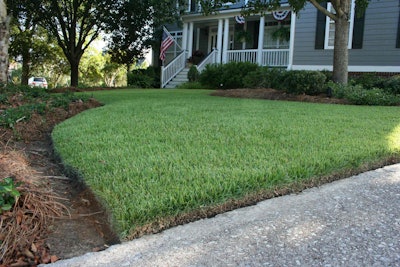 Photo: Sod Solutions
Photo: Sod SolutionsFor Wagner, the case for natural grass is a slam dunk, yet he makes it as if he’s standing on the floor of the U.S. Senate: “One of the things the healthiest cities in this country have in common is an abundance of natural landscaping,” he says. “Are we going to go the route of plastic shrubs, plastic trees?”
Lanfranco, to be sure, is equally prepared to make the case for synthetic turf in landscapes. And as you’d expect, his arguments alternate between water conservation and reduced maintenance costs.
But make no mistake: He’s also a salesman who believes in his product. Today, Lanfranco says, the quality and reliability of synthetic grass, coupled with the remarkable improvements in the aesthetics of the best products, have reached a level at which “it just makes sense,” whether in commercial and residential applications or on school playgrounds, roadway medians and other government sites.
Lanfranco readily acknowledges that the artificial turf market in the United States is concentrated in the West. “California is ground zero for synthetic grass,” he says, “followed by Arizona and Texas, then Nevada and Colorado. Those states account for 80 percent of sales” – again, in the landscaping part of the business.
And while he’s all too aware of the competition from the natural turf industry, the success of his own has produced plenty of competition for SGW among distributors of artificial grass. When he started SGW 11 years ago, he says, “we were the only major distributor of synthetic grass in California. There’s probably 40 today. You can buy it at Costco, Lowe’s, Home Depot – and of course that’s bringing even more acceptance.”
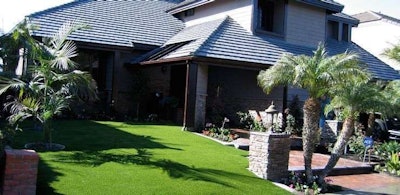 Photo: TurfTiger
Photo: TurfTigerLanfranco is candid about his industry’s dependence on the performance of installers – landscaping companies it doesn’t own. SGW’s marketing division offers workshops on proper installation. “Right now,” Lanfranco says, “we sell to about 3,500 installers nationwide. That’s an extremely important relationship. We bring in landscapers and show them how to install synthetic grass and how to market it.”
The artificial and natural turf industries’ indictments of each other’s products are long, detailed and not pretty. You can read them at their respective trade associations’ websites: the Synthetic Turf Council and Turfgrass Producers International.
Lanfranco and Wagner can cite chapter and verse on that front. Among other charges, the natural turf industry points to the creation of “heat islands” wherever synthetic grass is applied and the necessity of using large quantities of water in an effort to cool it down. The artificial turf industry says natural grass uses an unsustainable amount of water, which isn’t getting any less expensive, and is bad for the environment because of the chemicals used to fertilize it and kill pests and diseases.
“You can have a beautiful green lawn without watering it,” Lanfranco says. “We’re proud of how much water has been saved.”
Nonsense, Wagner says, “although it’s true that people tend to use too much water on their lawns. We’ve seen research that says 50-to-80 percent of the water that’s put on grass isn’t needed. It isn’t just wasteful; it’s bad for the grass.”
With the exception of its use as a substitute for natural turf in areas of extreme drought – a practice he believes will do more harm than good in the long run – and “maybe in some Northern states where the temperatures are bitter cold,” Wagner maintains that artificial grass has no place in American landscapes.
“Can you imagine the heat in a place like Los Angeles as natural grass is pulled back?” he asks. “Besides, they could achieve 25-percent water savings simply by switching to warm-season grasses.”
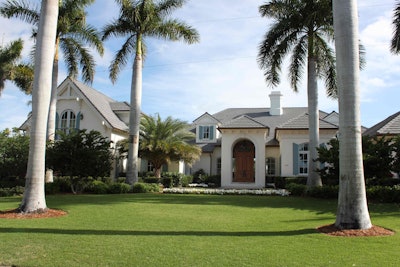 Photo: Sod Solutions
Photo: Sod SolutionsThe artificial turf industry has a very effective lobby, Wagner says, “and they’ve spent millions to project themselves – their product – as normal. It isn’t normal, but it is hugely profitable.”
For his part, Lanfranco isn’t concerned about the market for synthetic turf hitting a peak. He’s worried about filling orders. And even without verifiable data to prove it, there’s little doubt the demand for artificial grass is high and rising.


